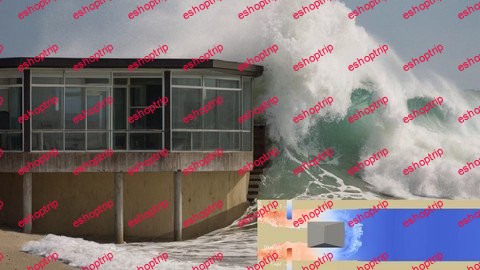Published 1/2024
MP4 | Video: h264, 1920×1080 | Audio: AAC, 44.1 KHz
Language: English | Size: 2.07 GB | Duration: 2h 30m
Numerical Analysis, Wave Impacts, Breaking wave, wave-structure interaction, flow visualization
What you’ll learn
Understand how to get and install the free tools needed for numerical simulation and data analysis
Understand how to set up and perform validation method for wave force numerical simulation using free software
Able to generate flow visualization animation using the simulated particles data
Able to analyse the impact pressure data of the structure simulated
Requirements
No programming needed. Need computer and at least about 3Tb of storage ready.
No knowledge in fluid dynamics needed
Description
This course focuses on breaking wave impact analysis using numerical simulation called SPH. Traditionally, wave load analysis of a coastal structure is done theoretically. This, however, is very limited to certain ideal condition. Broken wave or large freak wave, such as tsunami wave, is highly irregular and non-linear, which makes them difficult to be analyzed theoretically. For these conditions, most engineers rely on experiment. While closer to real life application, physical experiments are expensive, time consuming, and require a high level of expertise. Numerical simulation combined the theoretical low cost with experimental accuracy, making it a suitable option for modern engineer. This course is intended for complete beginner with no prior understanding of coding and CFD. Some level of fluid-dynamics understanding maybe needed to understand the material, but not needed to perform the simulation. Upon the completion of this course, the learner is expected to be able to download and install all of the free-to-use software, run the simulation, animate the flow, and perform the basic data analysis. In this course you will be able to:1. edit the geometry model of your simulation 2. set up the correct simulation parameters value 3. run an SPH simulation 4. Validate your simulation to make sure the results is accurate4. View the fluid flow field using Paraview5. Analyze the simulation dataWho is the target of this course?Engineering students, engineer, animator, design student, or anyone with interest of fluid research. There is no knowledge in fluid dynamics needed for this course
Overview
Section 1: Introduction
Lecture 1 Introduction
Section 2: Download open source tools needed
Lecture 2 Getting the resources needed
Section 3: Validation
Lecture 3 Validation setup and parameters selection
Lecture 4 Validation data comparison with experimental results
Section 4: Wave impact simulation setup
Lecture 5 Wave impact simulation parameter setup
Section 5: Wave impact analysis
Lecture 6 Wave impact simulation visualization and data analysis
Engineering student, professional, animator, architect
Homepage
https://anonymz.com/?https://www.udemy.com/course/complete-tutorial-for-beginner-on-wave-impact-analysis/










